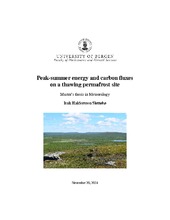Peak-summer energy and carbon fluxes on a thawing permafrost site
Master thesis
Permanent lenke
https://hdl.handle.net/1956/18762Utgivelsesdato
2018-12-13Metadata
Vis full innførselSamlinger
- Geophysical Institute [1195]
Sammendrag
We present measurements of surface fluxes taken between 7 July and 6 August 2017, on a palsa mire near the Iškoras mountain in Finnmark, northern Norway. Palsa mires are a particular landform found at the edge of the discontinuous permafrost zone, where mean annual temperatures are close to 0 °C and climate change is expected to have a high impact. Turbulent fluxes of sensible heat, latent heat and carbon dioxide were measured with the eddy-covariance (EC) method, while complementary energy balance data was provided by a net radiometer and two soil heat flux plates. The raw turbulence data was processed by the validated TK3 software package, which applies the plausability tests, corrections and quality controls needed for reliable flux calculations. Through a footprint analysis we found the average turbulent fetch area to overlap well with our ecosystem of interest, in that only 20 % of the footprint climatology was outside the palsa mire. However, a greater carbon uptake was observed during northerly winds than otherwise, which suggests that the more vegetated area to the north of the palsa mire also influenced our flux measurements. Overall, our results are similar to those of other studies from the growing season at sub-Arctic sites. The mean daytime Bowen ratio was 74 %, which is typical for high-latitude wetlands in summertime. The soil heat flux was positive most of the time, and from our cumulative flux estimates we found a large soil heat uptake during the campaign, which is characteristic for permafrost regions during the warm season. However, the average flux from the upper sensor at 10 cm was only 8 % of the net radiation. This is in general less than what other permafrost studies have found for the ground heat flux, likely due to a change in heat storage above the 10 cm level. The average net ecosystem exchange of carbon dioxide during the campaign was –1.1 μmol/m2s, which indicates carbon uptake and compares well to what has been reported in other studies from similar sites in summertime. Differences in carbon budgets between sub-Arctic ecosystems seem to be associated with the vegetation cover. A certain long-term increase in carbon flux amplitude was found, likely related to vegetation growth. We were not able to verify the surface energy balance equation with our measurements, but using longwave radiation data we managed to estimate the true ground heat flux at the surface. This gave a better, though not perfect, balance. Our ogive test suggested that a significant fraction of the turbulent fluxes were inadequately sampled with a block averaging period of only 30 min, which also contributed to the observed imbalance in surface heat fluxes.
